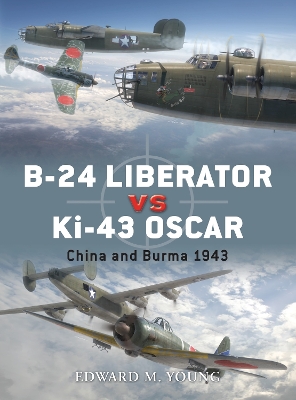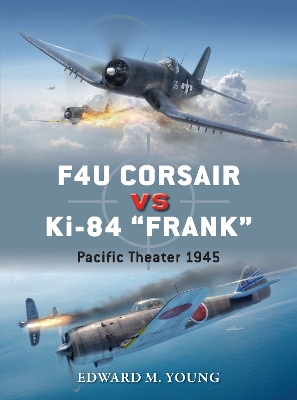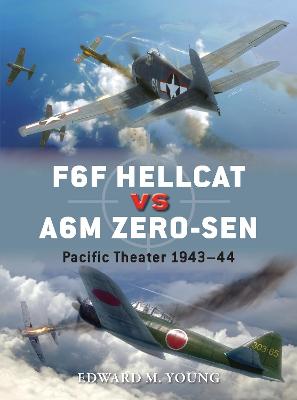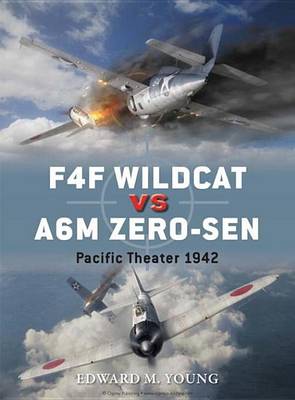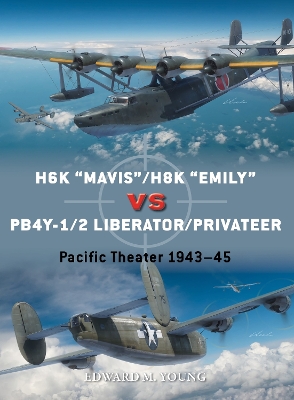Duel
5 total works
In reviewing reports of air combat from Spain, China and the early stages of the war in Europe, the US Army Air Corps called for heavier armor and armament for its bomber fleet, including the addition of a tail turret. While Japan tried to counter with their own heavy fighters, their inability to produce them in any number meant that they were forced to face the bomber threat with the nimble, but under-armed Ki-43 "Oscar". While severely outgunned, the Japanese learned to use their greater maneuverability to exploit the small weakness in bomber defenses. This book tells the story of the clash in the skies over the Pacific, as the Japanese fought desperately against the coming tide of the American bomber offensive.
The Vought Corsair was the first American single-engined fighter to exceed 400 mph and establish dominance over the legendary Mitsubishi Type Zero-sen. The Ki-84 Hayate was introduced by the Japanese specifically to counter this growing American dominance of the skies over the Pacific. Built in greater numbers than any other late war Japanese fighter, nearly 3000 were completed between 1944 and 1945. This volume examines the clashes between the Corsair and Ki-84 in the closing stages of the war, revealing how Corsair pilots had to adapt their techniques and combat strategies to adapt to these newer types. It also reveals how the kill rate was largely driven by the reduced quality of fighter pilots after the high casualty rates inflicted on the Japanese air force during the air battles over the Solomon Islands.
The Grumman F6F Hellcat and Mitsubishi A6M Zero-sen were the two principal opposing fighters in the brutal aerial clashes of the Pacific War from 1943 onwards. Reminiscent of the preceding F4F Wildcat, the F6F Hellcat was designed specifically to counter the earlier A6M2 Zero-sen, the strengths and weaknesses of which became fully understood by US designers after an undamaged example was recovered in the Aleutians. The powerful Hellcat had an impressive top speed, rate of climb and armament, and it retained its predecessor's incredible ruggedness. The A6M5 Zero-sen was also born out of an earlier type, but was intended merely as a stop-gap until more modern Japanese fighters could be produced to restore performance parity with Allied aircraft. The chaotic conditions of the Japanese Aircraft industry and war economy prevented new types from being built.Featuring detailed artwork illustrating the technical specifications of these two types and the dramatic encounters between them, this volume focuses on how these iconic fighters came into being, and how they fared as they faced one another over the Pacific skies of World War II.
The Grumman F4F Wildcat and the Mitsubishi A6M Zero-sen were contemporaries, although designed to very different requirements. The Wildcat, ruggedly built to survive the rigors of carrier operations, was the best carrier fighter the US Navy had available when the USA entered World War II, and it remained the principal fighter for the US Navy and the US Marine Corps until 1942-43. With a speed greater than 300mph, exceptional manoeuvrability, long range, and an impressive armament the slick Zero-sen could out-perform any Allied fighter in 1941-42. The battles between the Wildcat and the Zero-sen during 1942 represent a classic duel in which pilots flying a nominally inferior fighter successfully developed air-combat tactics that negated the strengths of their opponent.
H6K “Mavis”/H8K “Emily” vs PB4Y-1/2 Liberator/Privateer
by Edward M. Young
Published 16 February 2023
An illustrated exploration of the dramatic aerial combats between the US Navy's long-range bomber and Japanese flying boats in the Pacific War.
Edward Young explores these rarely written about combats, examining the aggressive and strategic tactics deployed by both US Navy and Imperial Japanese Navy Air Force and analyzing the technical improvements installed throughout the war.
The PB4Y-1/2 Liberator/Privateer was the US Navy’s first four-engined, land-based bomber, adapted and allocated to fight the U-boat menace in the Atlantic and protect the vast reaches of the Pacific Ocean. The long range, speed, armament and bomb load of the PB4Y-1 enabled the US Navy’s Pacific squadrons to adopt more aggressive tactics. The PB4Y-1, and its follow-on PB4Y-2, engaged in dangerous bombing missions against Japanese installations, shipping strikes, and air combat.
On the other side, with its doctrine of making the first strike against an enemy fleet, the Imperial Japanese Navy recognized the vital importance of maritime reconnaissance, relying on carrier-based reconnaissance aircraft, ship-borne floatplanes and, for long-range maritime patrol, flying boats. The Japanese would continue to develop their aircraft throughout the war, resulting, among others, in the H6K ‘Mavis’ and the H8K2 ‘Emily’, which despite never achieving a victory, was regarded by the Allied pilots as the most difficult Japanese aircraft to destroy.
Enriched with specially commissioned artwork, including armament and cockpit views, battlescenes and technical diagrams, this title analyses technical specifications in detail. By including first-hand accounts, aviation expert Edward Young provides a detailed account of these one-sided yet dramatic and aggressive combats.
Edward Young explores these rarely written about combats, examining the aggressive and strategic tactics deployed by both US Navy and Imperial Japanese Navy Air Force and analyzing the technical improvements installed throughout the war.
The PB4Y-1/2 Liberator/Privateer was the US Navy’s first four-engined, land-based bomber, adapted and allocated to fight the U-boat menace in the Atlantic and protect the vast reaches of the Pacific Ocean. The long range, speed, armament and bomb load of the PB4Y-1 enabled the US Navy’s Pacific squadrons to adopt more aggressive tactics. The PB4Y-1, and its follow-on PB4Y-2, engaged in dangerous bombing missions against Japanese installations, shipping strikes, and air combat.
On the other side, with its doctrine of making the first strike against an enemy fleet, the Imperial Japanese Navy recognized the vital importance of maritime reconnaissance, relying on carrier-based reconnaissance aircraft, ship-borne floatplanes and, for long-range maritime patrol, flying boats. The Japanese would continue to develop their aircraft throughout the war, resulting, among others, in the H6K ‘Mavis’ and the H8K2 ‘Emily’, which despite never achieving a victory, was regarded by the Allied pilots as the most difficult Japanese aircraft to destroy.
Enriched with specially commissioned artwork, including armament and cockpit views, battlescenes and technical diagrams, this title analyses technical specifications in detail. By including first-hand accounts, aviation expert Edward Young provides a detailed account of these one-sided yet dramatic and aggressive combats.
